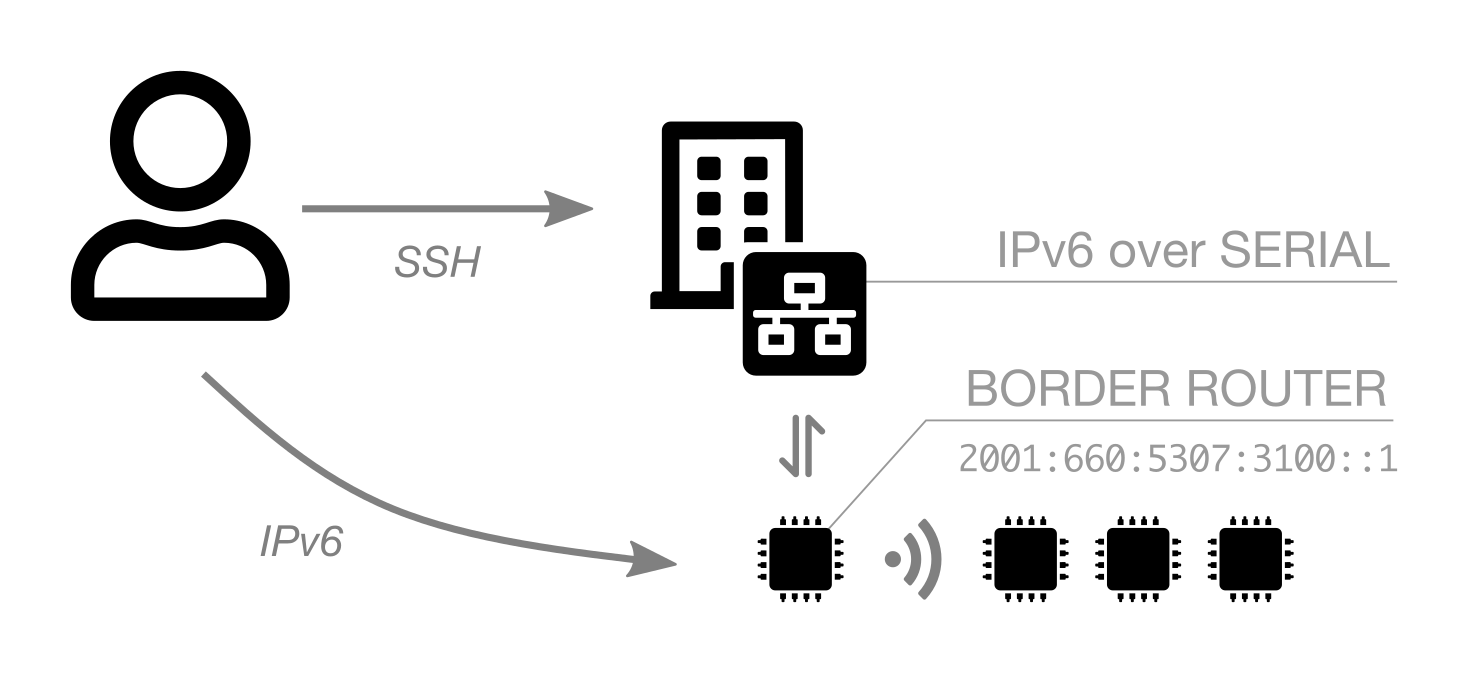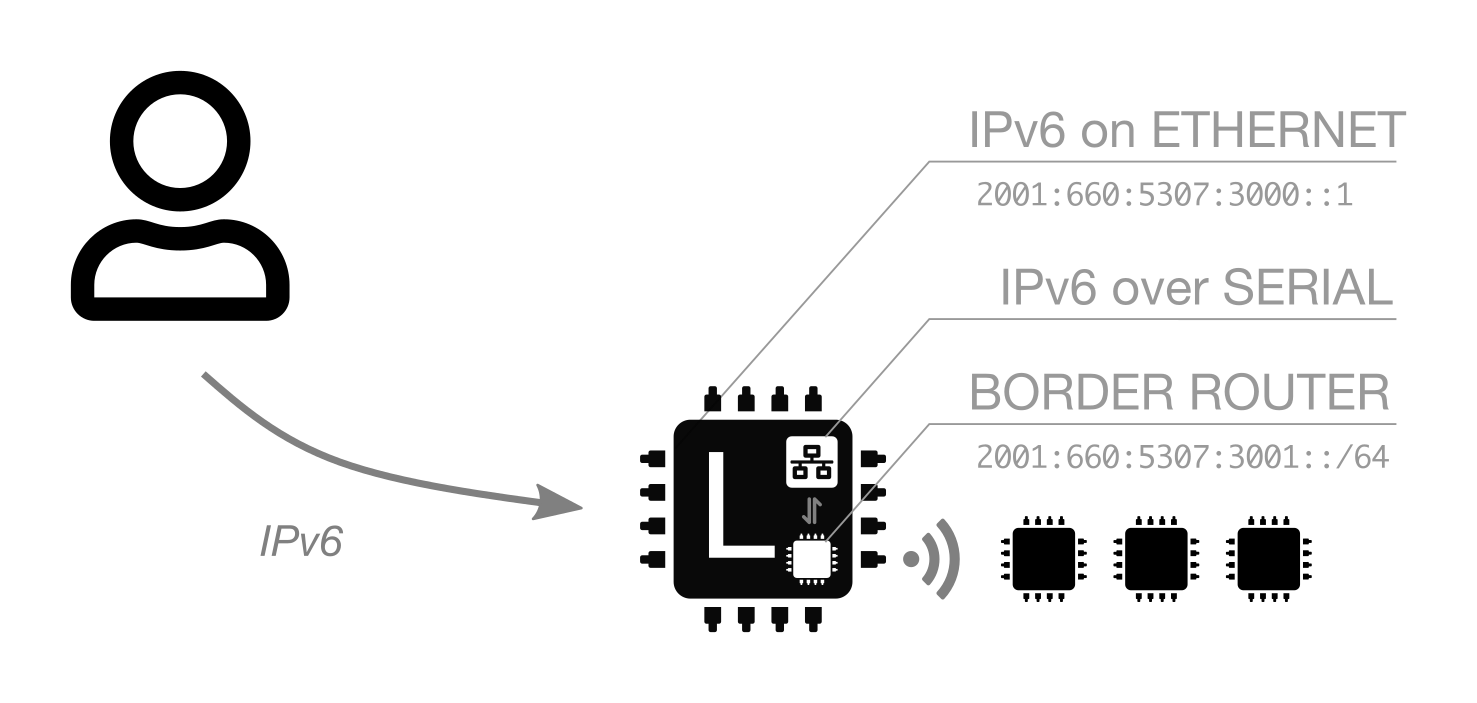IPv6
This page describes the public IPv6 support available on the IoT-LAB testbed. You will find out how to build a private or public IPv6 network.
Introduction
IPv6 is the most recent version of the IP protocol developed by the IETF. IPv6 offers larger address and solves the problem of IPv4 address exhaustion and also offers new features. An IPv6 address is represented by a series of 128 bits or 16 bytes, and is represented with a hexadecimal notation. For example, a public IPv6 address, so-called global unicast address that is to say routable, can have the following full representation:
2001:0660:5307:30ff:0000:0000:0000:0001
- One or more leading zeros from any groups of hexadecimal digits are removed;
this is usually done to either all or none of the leading zeros. For example,
the group
0042is converted to42. - A series of 0 contiguous is replaced only once by
::
Thus, the previous address can be shortened to:
2001:660:5307:30ff::1
This 128 bits address is often divided into 2 parts:
- the most-significant 64 bits are used as the routing prefix (
2001:660:5307:30ff::/64in our example) - the least-significant 64 bits correspond to the address of the host (
::1in our example); generally, they are constructed from the MAC address of the host to guarantee the uniqueness of an IPv6 address in a subnet or randomly generated for privacy reason.
Some prefixes are reserved for very specific uses:
- fe80::/10 is used for unicast addresses called link-local. This type of address only allows 2 network nodes to communicate if they share a direct physical link.
- fd00::/8 is intended for Unique Local Address addresses. These addresses correspond to private addresses in IPv4 and are not routable.
For boards based on a microcontroller
In order for an embedded board to communicate in IPv6 with a host on the Internet, it needs an IPv6 global unicast address. To do this, another embedded board play the role of Border Router (BR) and must be added in the network. It will be responsible for propagating an IPv6 global prefix and assign an address to the device. We speak here of BR, because it’s on the border between a radio network (e.g. 802.15.4) and a classic Ethernet network. Technically, the IPv6 traffic between the SSH frontend and the BR radio interface is routed via a virtual network interface (i.e. TUN or TAP interface) and the IPv6 traffic is encapsulated on the BR’s serial link.

To do so, we provide a pool of public IPv6 /64 prefixes per site that can be used to build an IPv6 network. They are listed in the table below:
| Site | Number of subnets | Prefixes, from | to |
|---|---|---|---|
| Grenoble | 128 | 2001:660:5307:3100::/64 | 2001:660:5307:317f::/64 |
| Lille | 128 | 2001:660:4403:0480::/64 | 2001:660:4403:04ff::/64 |
| Saclay | 64 | 2001:660:3207:04c0::/64 | 2001:660:3207:04ff::/64 |
| Strasbourg | 32 | 2a07:2e40:fffe:00e0::/64 | 2a07:2e40:fffe:00ff::/64 |
Selecting an already used prefix may bring to an “overlaps with routes” error while creating the IPv6 over serial interface. To see currently used IPv6 prefixes on a site, use this command from its SSH frontend:
<login>@grenoble:~$ ip -6 route
...
2001:660:5307:3100::/64 dev tun0 proto kernel metric 256 mtu 1500 advmss 1440 hoplimit 4294967295
2001:660:5307:3102::/64 dev tun7 proto kernel metric 256 mtu 1500 advmss 1440 hoplimit 4294967295
2001:660:5307:3107::/64 dev tap3 proto kernel metric 256 mtu 1500 advmss 1440 hoplimit 4294967295
...
See the dedicated section of the OS documentation to know how to use this feature:
- with RIOT using ETHOS (Ethernet Over Serial);
- with Contiki-NG using SLIP (Serial Line Internet Protocol).
For boards running an embedded Linux
During an experiment, boards running an embedded Linux have a public IPv6 address assigned to their Ethernet interface. They are directly accessible:
- from any other embedded Linux board currently running,
- from any board of the testbed based on a microcontroller having a public IPv6 address,
- from any IoT-LAB SSH frontend,
- and, on the whole, from any public IPv6 address on the Internet.
Each site has a /64 IPv6 prefix, in which each embedded Linux node will get its static IPv6 address. Its IPV6 configuration can be known with the following environment variables:
root@node-a8-1:~# printenv
...
GATEWAY6_ADDR=2a07:2e40:fffe:00c0:ff::
INET6_ADDR=2a07:2e40:fffe:00c0::1/64
...
Mixing two types of boards
It is possible to test common IoT scenarios that implies communications between sensors and an application gateway, the later needing to have a more powerfull environment. Boards based on a microcontroller play the role of sensors and a board running embedded Linux, equipped with a co-microcontroller managing a radio interface, plays the role of the gateway.
In that case, it’s therefore quite possible to build an IPv6 network with the co-microcontroller acting as a Border Router and communicating with other nodes by radio (e.g. 802.15.4). Unlike the setup with a microcontroller on the SSH frontend, the creation of the virtual network interface and IPV6 traffic encapsulation is done directly on the embedded Linux node using the co-microcontroller serial’s link.

Each embedded Linux node has a dedicated /64 IPv6 prefix to build its IPv6 subnet; each node based on a microcontroller will have a public IPv6 address assigned in this subnet. This configuration can be known with the following environment variables:
root@node-a8-1:~# printenv
...
INET6_PREFIX_LEN=64
INET6_PREFIX=2a07:2e40:fffe:c1
...
See the dedicated section of the OS documentation to know how to install and use the needed tools for that:
- RIOT using ETHOS (Ethernet Over Serial);
- Contiki-NG using SLIP (Serial Line Internet Protocol).